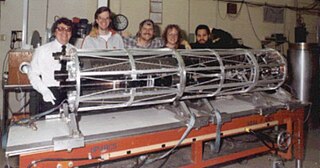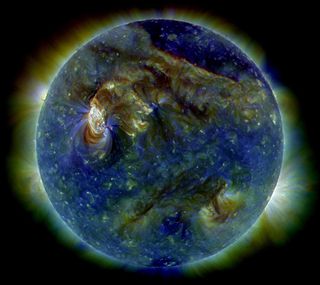Related Research Articles

A corona is the outermost layer of a star's atmosphere. It consists of plasma.

A solar flare is a relatively intense, localized emission of electromagnetic radiation in the Sun's atmosphere. Flares occur in active regions and are often, but not always, accompanied by coronal mass ejections, solar particle events, and other eruptive solar phenomena. The occurrence of solar flares varies with the 11-year solar cycle.
The Extreme ultraviolet Imaging Telescope (EIT) is an instrument on the SOHO spacecraft used to obtain high-resolution images of the solar corona in the ultraviolet range. The EIT instrument is sensitive to light of four different wavelengths: 17.1, 19.5, 28.4, and 30.4 nm, corresponding to light produced by highly ionized iron (XI)/(X), (XII), (XV), and helium (II), respectively. EIT is built as a single telescope with a quadrant structure to the entrance mirrors: each quadrant reflects a different colour of EUV light, and the wavelength to be observed is selected by a shutter that blocks light from all but the desired quadrant of the main telescope.

Transition Region and Coronal Explorer was a NASA heliophysics and solar observatory designed to investigate the connections between fine-scale magnetic fields and the associated plasma structures on the Sun by providing high resolution images and observation of the solar photosphere, the transition region, and the solar corona. A main focus of the TRACE instrument is the fine structure of coronal loops low in the solar atmosphere. TRACE is the third spacecraft in the Small Explorer program, launched on 2 April 1998, and obtained its last science image on 21 June 2010, at 23:56 UTC.
Solar physics is the branch of astrophysics that specializes in the study of the Sun. It intersects with many disciplines of pure physics and astrophysics.

The Multi-spectral solar telescope array, or MSSTA, was a sounding rocket payload built by Professor A.B.C. Walker, Jr. at Stanford University in the 1990s to test EUV/XUV imaging of the Sun using normal incidence EUV-reflective multilayer optics. MSSTA contained a large number of individual telescopes, all trained on the Sun and all sensitive to slightly different wavelengths of ultraviolet light. Like all sounding rockets, MSSTA flew for approximately 14 minutes per mission, about 5 minutes of which were in space—just enough time to test a new technology or yield "first results" science. MSSTA is one of the last solar observing instruments to use photographic film rather than a digital camera system such as a CCD. MSSTA used film instead of a CCD in order to achieve the highest possible spatial resolution and to avoid the electronics difficulty presented by the large number of detectors that would have been required for its many telescopes.

Extreme ultraviolet radiation or high-energy ultraviolet radiation is electromagnetic radiation in the part of the electromagnetic spectrum spanning wavelengths shorter that the hydrogen Lyman-alpha line from 121 nm down to the X-ray band of 10 nm, and therefore having photons with energies from 10.26 eV up to 124.24 eV. EUV is naturally generated by the solar corona and artificially by plasma, high harmonic generation sources and synchrotron light sources. Since UVC extends to 100 nm, there is some overlap in the terms.

The Solar Dynamics Observatory (SDO) is a NASA mission which has been observing the Sun since 2010. Launched on 11 February 2010, the observatory is part of the Living With a Star (LWS) program.

Hinode, formerly Solar-B, is a Japan Aerospace Exploration Agency Solar mission with United States and United Kingdom collaboration. It is the follow-up to the Yohkoh (Solar-A) mission and it was launched on the final flight of the M-V rocket from Uchinoura Space Center, Japan on 22 September 2006 at 21:36 UTC. Initial orbit was perigee height 280 km, apogee height 686 km, inclination 98.3 degrees. Then the satellite maneuvered to the quasi-circular Sun-synchronous orbit over the day/night terminator, which allows near-continuous observation of the Sun. On 28 October 2006, the probe's instruments captured their first images.

In solar physics, a coronal loop is a well-defined arch-like structure in the Sun's atmosphere made up of relatively dense plasma confined and isolated from the surrounding medium by magnetic flux tubes. Coronal loops begin and end at two footpoints on the photosphere and project into the transition region and lower corona. They typically form and dissipate over periods of seconds to days and may span anywhere from 1 to 1,000 megametres in length.
The Sun Watcher using Active Pixel System Detector and Image Processing (SWAP) telescope is a compact extreme-ultraviolet (EUV) imager on board the PROBA-2 mission. SWAP provides images of the solar corona at a temperature of roughly 1 million degrees. the instrument was built upon the heritage of the Extreme ultraviolet Imaging Telescope (EIT) which monitored the solar corona from the Solar and Heliospheric Observatory from 1996 until after the launch of the Solar Dynamics Observatory in 2010.
The NIXT, or Normal Incidence X-ray Telescope, was a sounding rocket payload flown in the 1990s by Professor Leon Golub of the Smithsonian Astrophysical Observatory, to prototype normal-incidence (conventional) optical designs in extreme ultraviolet (EUV) solar imaging. In the EUV, the surface of the Sun appears dark, and hot structures in the solar corona appear bright; this allows study of the structure and dynamics of the solar corona near the surface of the Sun, which is not possible using visible light.

OSO 7 or Orbiting Solar Observatory 7, before launch known as OSO H is the seventh in the series of American Orbiting Solar Observatory satellites launched by NASA between 1962 and 1975. OSO 7 was launched from Cape Kennedy on 29 September 1971 by a Delta N rocket into a 33.1° inclination, low-Earth orbit, and re-entered the Earth's atmosphere on 9 July 1974. It was built by the Ball Brothers Research Corporation (BBRC), now known as Ball Aerospace, in Boulder Colorado.

Interface Region Imaging Spectrograph (IRIS), also called Explorer 94 and SMEX-12, is a NASA solar observation satellite. The mission was funded through the Small Explorer program to investigate the physical conditions of the solar limb, particularly the interface region made up of the chromosphere and transition region. The spacecraft consists of a satellite bus and spectrometer built by the Lockheed Martin Solar and Astrophysics Laboratory (LMSAL), and a telescope provided by the Smithsonian Astrophysical Observatory (SAO). IRIS is operated by LMSAL and NASA's Ames Research Center.

A nanoflare is a very small episodic heating event which happens in the corona, the external atmosphere of the Sun.

Supra-arcade downflows (SADs) are sunward-traveling plasma voids that are sometimes observed in the Sun's outer atmosphere, or corona, during solar flares. In solar physics, arcade refers to a bundle of coronal loops, and the prefix supra indicates that the downflows appear above flare arcades. They were first described in 1999 using the Soft X-ray Telescope (SXT) on board the Yohkoh satellite. SADs are byproducts of the magnetic reconnection process that drives solar flares, but their precise cause remains unknown.
Katharine Reeves is an astronomer and solar physicist who works at the Center for Astrophysics | Harvard & Smithsonian (CfA). She is known for her work on high temperature plasmas in the solar corona, and measurement/analysis techniques to probe the physics of magnetic reconnection and thermal energy transport during solar flares; these are aspects of the coronal heating problem that organizes a large part of the field. She has a strong scientific role in multiple NASA and international space missions to observe the Sun: Hinode ; IRIS ; SDO; Parker Solar Probe; and suborbital sounding rockets including the MaGIXS and Hi-C FLARE high-resolution spectral imaging packages.
Polarimeter to Unify the Corona and Heliosphere (PUNCH) is a future mission by NASA to study the unexplored region from the middle of the solar corona out to 1 AU from the Sun. PUNCH will consist of a constellation of four microsatellites that through continuous 3D deep-field imaging, will observe the corona and heliosphere as elements of a single, connected system. The four microsatellites were initially scheduled to be launched in October 2023, but they have since been moved to an April 2025 launch in rideshare with SPHEREx.
Darrell Lynn Judge was an American physicist, known for his research in solar physics, spectroscopy, and space science.
Amir Caspi is a solar physicist based at the Southwest Research Institute in Boulder, Colorado. He is particularly known for his work on X-ray spectroscopy of the Sun and the solar corona, and for advancing the art of eclipse observations of the corona to improve scientific understanding.
References
- ↑ Seaton, D.B., et al. 2013: "The SWAP EUV Imaging Telescope Part I: Instrument Overview and Pre-Flight Testing", Solar Physics, 286, 43 (doi:10.1007/s11207-012-0114-6)
- ↑ Seaton, D.B., de Groof, A., Shearer, P., Berghmans, D., and Nicula, B. 2013: "SWAP observations of the Long-Term, Large-Scale Evolution of the EUV Solar Corona", Astrophysical Journal 777, 72 (doi:10.1088/0004-637X/777/1/72)
- ↑ Seaton, D.B., et al. 2021: "The Sun's dynamic extended corona observed in extreme ultraviolet", Nature Astronomy 5, 1029 (doi:10.1038/s41550-021-01427-8)